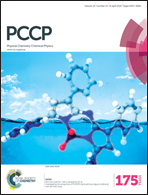Paramagnetic dioxovanadium(iv) molecules inside the channels of zeolite BEA – EPR screening of VO2 reactivity toward small gas-phase molecules†
Abstract
Interaction of small gas-phase molecules (NO, N2O, O2, CO) with VO2 radicals inside the channels of a dealuminated SiBEA zeolite was investigated by means of electron paramagnetic resonance (EPR), infrared (IR), and mass (QMS) spectroscopies to provide direct insights into the chemistry of a unique paramagnetic state of vanadium – VO2 molecules. A facile way of forming VO2 inside the channels of SiBEA via thermal reduction of VO2+ precursor cations was shown. Dioxovanadium(IV) was identified based on its unusual EPR signal which, as compared with the typical monooxovanadium(IV) (VO2+ cation), is featured by rhombic symmetry and a positive Aiso value leading to a hyperfine splitting as large as 32 mT. VO2 molecules exhibit reducing properties transforming N2O and O2 into vanadium intrachannel cage adducts comprising of reactive oxygen species (O− and O2−, respectively). Interaction with CO led to its oxidation to CO2, while paramagnetic NO acted as a scavenger for VO2 radicals producing diamagnetic adducts. The observed reactivity was rationalized in terms of spin-pairing, electron transfer, and oxygen transfer processes. As a result new chemical pathways of vanadium reactivity were demonstrated which were not observed so far either in the homogeneous molecular systems or supported vanadium materials.


 Please wait while we load your content...
Please wait while we load your content...